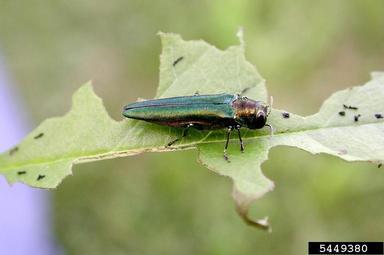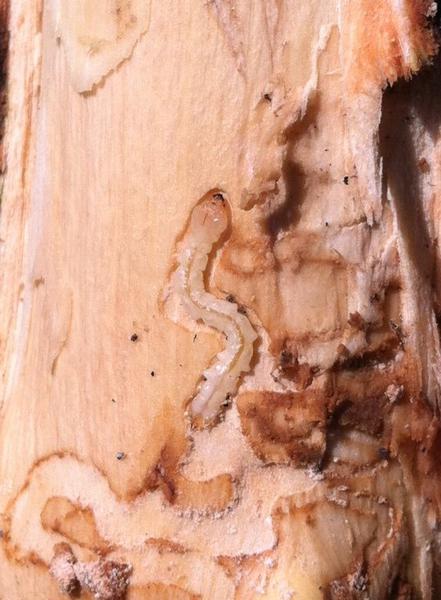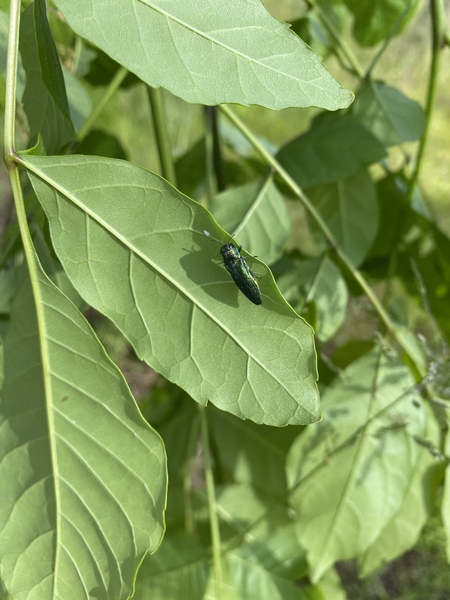Introduction
The emerald ash borer (EAB; Agrilus planipennis) is a non-native invasive pest from Asia that has already killed millions of ash trees. It was first detected in the United States near Detroit, Michigan in 2002. Since then, it has spread to 37 U.S. states and 5 Canadian provinces (as of 2025). It was first found in North Carolina in 2013 and is now prevalent across much of the state (Figure 12).
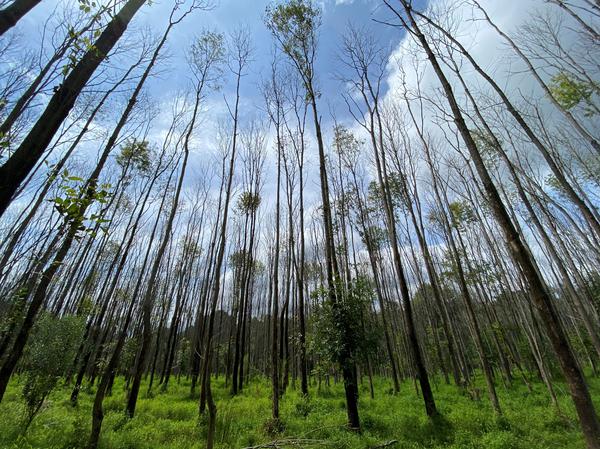
Figure 3. The emerald ash borer has already killed millions of ash trees in the United States. This stand is heavily infested with most trees in decline.
Kelly Oten CC BY 4.0
Host Plants
The EAB is an extremely damaging pest of all North American ash trees (Fraxinus spp.). In North Carolina, this includes green ash, white ash, Carolina ash, and pumpkin ash. Tree death is almost certain unless a suitable pesticide is applied. White fringetree (Chionanthus virginicus), a small, native flowering tree, is a secondary host and may also be attacked but not as frequently. Mountain-ash (Sorbus americana) is not a true ash and is not susceptible to the EAB.
Damage and Symptoms
Emerald ash borer larvae feed in the inner bark (phloem) and outer wood (xylem), disrupting the transportation of nutrients and water within the tree. This causes canopy thinning (Figure 3), branch dieback, and / or epicormic sprouting from the trunk. In addition, increased woodpecker activity is often prevalent on infested trees (woodpeckers fleck off bark and feed on larvae hidden beneath the bark) (Figure 8).
Feeding by larvae beneath the bark can cause vertical splits in the bark (Figure 7) and if the bark is removed, serpentine “tunnels” (galleries) are present (Figure 5, Figure 6). One of the most recognizable signs of EAB infestation is 1/8” D-shaped exit holes, created as the adult beetle exits the tree (Figure 4). Infestations often begin in the top of the tree and work their way down, so D-shaped exit holes at eye-level are typically not observable for several years.
Usually once symptoms are observed, trees have already been infested for at least 1-2 years. Tree death typically occurs within 5 years of initial infestation.

Figure 4. Adult emerald ash borer leave D-shaped exit holes as it exits the tree.
Kelly Oten CC BY 4.0
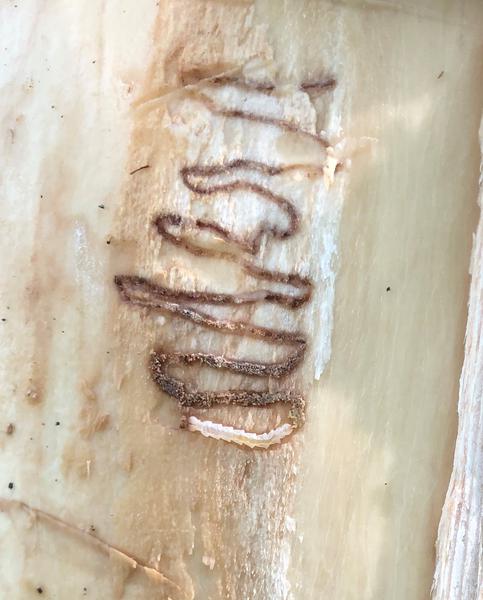
Figure 6. Young emerald ash borer larvae create smaller galleries, often in a S-shape.
Kelly Oten CC BY 4.0
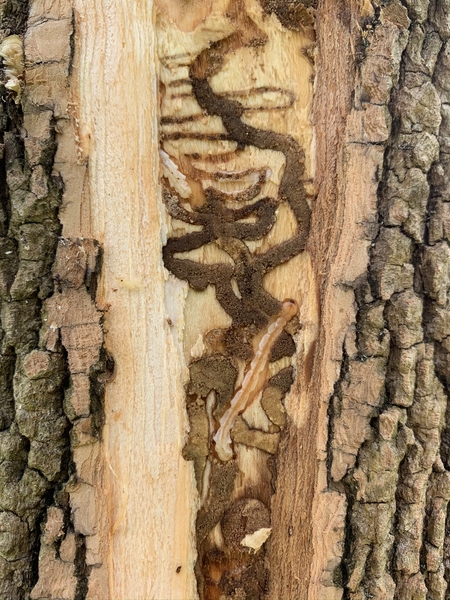
An older emerald ash borer larva creates wider galleries as it grows.
Ryan Bohannon, NC State University CC BY 4.0
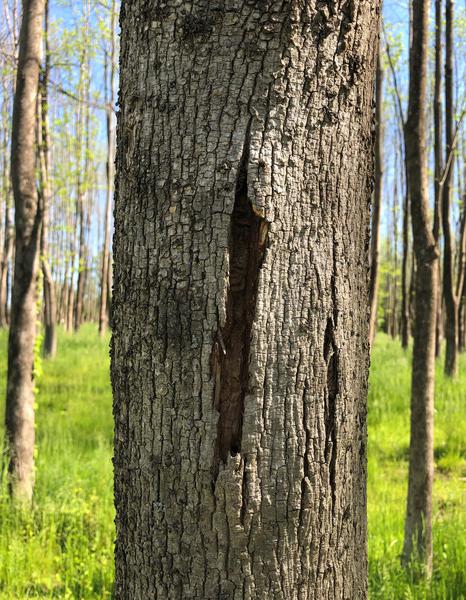
Figure 7. Vertical splits in the bark may result from larval feeding beneath the bark.
Kelly Oten CC BY 4.0
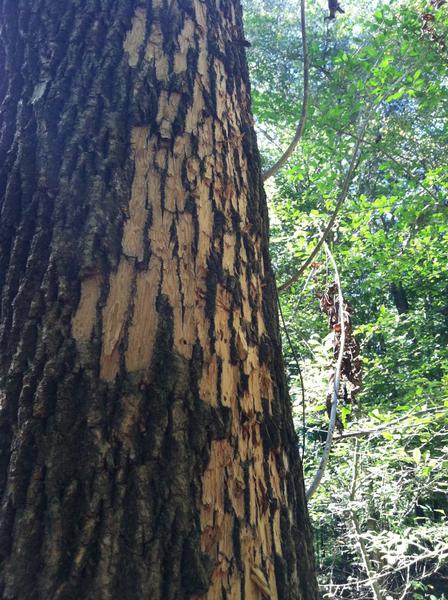
Figure 8. Woodpecker flecking is common in trees infested with emerald ash borer.
Kelly Oten CC BY 4.0
Life Cycle
In central North Carolina, EAB has one generation per year. Depending on seasonal weather, adult EAB emerge as early as April through mid-summer. They are short-lived (3-4 weeks), feeding on ash leaves before mating, laying eggs on tree bark, and dying. Eggs hatch about three weeks later and young larvae bore into the bark to begin feeding. They create tunnels (galleries), which become wider as they feed and grow (Figure 5, Figure 6). They spend the winter as inactive larvae within chambers in the outer inch of xylem (Figure 9) or the outer bark. They pupate the following spring (Figure 10) and emerge as adults about a month later. At high elevations, such as the Appalachian Mountains in westner NC, EAB can develop more slowly, taking two years to complete its life cycle and spending their first winter as young larvae (Courtney Johnson, unpublished data).
Identification
As the name suggests, adult EAB are a striking metallic green color (Figure 1). They are about ½” long and if their wing covers (elytra) are pried up, their bodies are metallic purple-red (Figure 11). In North Carolina, adults may be present as early as April through mid-summer. Larvae can be found beneath the bark from mid-summer through the following spring. They are cream-colored and grow up to 1.25” in length (Figure 2). There are other cream-colored larvae that can occur beneath bark, but the emerald ash borer can be distinguished by bell-shaped body segments.
Range Expansion
The EAB is one of the most quickly-spreading invasive forest pests to ever invade North Carolina. The current range of EAB is actively monitored by the N.C. Forest Service.
Upon emergence, adult EAB fly to a suitable tree. However, this dispersal is limited to 5 or fewer miles a year. The greater risk of spread comes from the accidental movement of EAB-infested materials by human activities.
The EAB and many other non-native invasive species (e.g., Asian longhorned beetle, redbay ambrosia beetle) can be accidentally transported in firewood or infested material. Therefore, it is highly recommended that untreated firewood be burned within 50 miles of where it was cut. If firewood must be transported, heat-treated or kiln-dried firewood should be used. A federal domestic quarantine, which regulated the movement of ash material and hardwood firewood (firewood is wood cut to 4 feet in length or less), was lifted on January 14, 2021, due to being ineffective at slowing the spread of EAB.
Management
High-value trees. High-value ash trees (e.g., urban, residential, parks) can be protected from the emerald ash borer using systemic insecticides. Systemic insecticides are distributed throughout the tree by the xylem. Because the xylem is damaged from emerald ash borer feeding, the ability of a tree to disburse chemical decreases as the infestation grows. Therefore, it is best to begin treatments before a tree is infested. Studies indicate if 50% or more of the canopy has been killed, it is likely too late to save the tree. Infested trees must heal following treatment, therefore improvement may not be apparent for 2 or more years.
Based on research trials, the most effective and longest-lasting treatment is a stem-injection of emamectin benzoate. In North Carolina, this pesticide must be applied by a licensed applicator and applications should occur every 2-3 years. Applications of neonicotinoids labeled for EAB management (e.g., imidacloprid, dinotefuran) are a more economical pesticide option, but they must be reapplied annually and are not as effective in killing EAB.
If they remain healthy, urban trees are considered most valuable as shade trees. However, depending on the objectives of the landowner, infested ash trees may be removed. When selecting trees for replanting, it is recommended to plant diverse species so that if/when another threat becomes an issue, one does not lose all of their trees at once. Certified arborists can help in treatments and removal decisions related to infested ash in urban or residential areas.
Forest ecosystems. In forest settings, pesticides are often not feasible due to application and economic limitations. NC State University and the North Carolina Forest Service cooperates with the USDA-APHIS EAB Biological Control Program which aims to establish natural enemies of the EAB in a long-term approach to sustainable management. Four species of parasitoid wasps have been released across 7 sites in North Carolina and they are not yet available to private landowners.
Managed forests and plantations. Given the extent of EAB in North Carolina, land managers should have a management plan in place. Ash timber should be regularly monitored for the presence of EAB. If EAB is detected, a salvage harvest should be considered. EAB feeds in the outer portions of the xylem, so infested trees may still be valuable if harvested promptly. Land managers interested in determining the value of their ash resources should contact a consulting forester.
Other Resources
Herms DA, McCullough DG, Clifford CS, Smitley DR, Miller FD, Cranshaw W. 2019. Insecticide options for protecting ash trees from emerald ash borer. North Central IPM Center Bulletin. 3rd Edition. 16 pp.
Biological Control of Emerald Ash Borer in North Carolina
N.C. Forest Service: Emerald ash borer FAQs.
N.C. Forest Service: Managing emerald ash borer in urban areas.
Publication date: Dec. 16, 2020
Reviewed/Revised: Oct. 30, 2025
N.C. Cooperative Extension prohibits discrimination and harassment regardless of age, color, disability, family and marital status, gender identity, national origin, political beliefs, race, religion, sex (including pregnancy), sexual orientation and veteran status.

